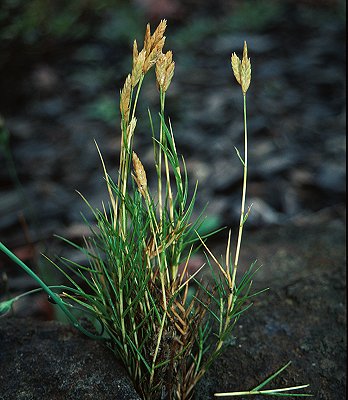 |
 |
|
 |
 |
|

Distichlis distichophylla (Labill.) Fassett |
Common name
Australian Saltgrass
Emu Grass
Salt Grass
Derivation
Distichlis Raf., J. Phys. Chim. Hist. Nat. Arts 89: 104 (1819);
from the Greek distichos (in 2 rows), referring to the conspicuous phyllotaxy.
distichophylla- from the Greek distichos (in two rows) and phyllon (leaf). Leaves arranges conspicuously in two rows.
Published in
Rhodora 27: 71 (1925).
Common synonyms
Distichlis spicata auct. non (L.) Greene
Habit
Perennial. Rhizomes elongated. Basal leaf sheaths glabrous. Culms decumbent,
7–60 cm tall. Mid-culm nodes glabrous. Leaves cauline, distichous. Leaf-sheaths
longer than adjacent culm internode. Ligule a fringed membrane, 0.1–0.5
mm long. Leaf-blades involute or convolute, 1–8(–20) cm long, 1–4
mm wide. Leaf-blade surface ribbed. Leaf-blade apex pungent. Dioecious.
Inflorescence
Inflorescence compound, a panicle of racemes, comprising 1–15 fertile spikelets.
Racemes 2–10, closely spaced, in a head, paucilateral, 0.5–4 cm long,
bearing few fertile spikelets. Central inflorescence axis 2.5–8 cm long.
Rhachis angular.
Spikelets
Spikelets solitary. Pedicels linear. Fertile spikelets many flowered, comprising
5–15 fertile florets, with diminished florets at the apex, lanceolate
or ovate, laterally compressed, 6–18(–28) mm long, breaking up at
maturity. Spikelets disarticulating below each fertile floret.
Glumes
Glumes persistent, similar, thinner than fertile lemma. Lower glume ovate, 2–4.1
mm long, 90% length of upper glume, scarious, 1-keeled, 3–9-nerved.
Lower glume apex acute. Upper glume ovate, 4–5 mm long, 100% of length
of adjacent fertile lemma, scarious, 1-keeled, 3–9-nerved. Upper glume
apex acute.
Florets
Fertile florets female. Fertile lemma ovate, 3–6.4 mm long, coriaceous,
5–11-nerved. Lemma surface glabrous. Lemma apex acute. Palea coriaceous,
2-nerved. Palea keels narrowly winged, eciliate or ciliolate. Palea
surface glabrous. Apical sterile florets resembling fertile though underdeveloped.
Anthers 3, 2 mm long. Male inflorescence similar to female, of racemes along
a central axis. Male spikelets similar to female but less developed, 5–20-flowered, persistent, ovate, 6–18 mm long. Male spikelet glumes 2. Male
spikelet lemma 5–11-nerved, muticous.
Continental Distribution:
Australasia, Pacific, North America, South America.
Australian Distribution:
Western Australia, South Australia, New South Wales, Victoria, Tasmania.
Western Australia: Eyre. South Australia: Lake Eyre, Flinders Ranges, Eyre Peninsula, Northern Lofty, Murray, Yorke Peninsula, Southern Lofty, Kangaroo Island, South-eastern. New South Wales: South-Western Plains. Victoria: Murray Mallee, Lowan Mallee, Wimmera, Wannon, Grampians, Riverina, Midlands, Victorian Volcanic Plain, Otway Plain, Otway Range, Gippsland Plains, Wilsons Promontory, East Gippsland. Tasmania: King Island, Furneaux Group, North West, Midlands, East Coast.
Classification. (GPWG
2001):
Chloridoideae: Cynodonteae
Notes
Native. Mainly near-coastal areas, and inland around saline wetlands. Flowers summer.

Habit (photo)
© Queensland Herbarium
Sharp 138 and Simon
by D.Sharp